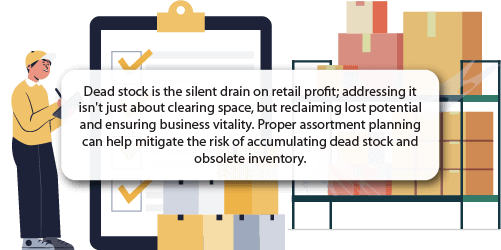As a small retailer, you undoubtedly know the burden of unsold inventory. Lurking in the backrooms or hidden corners of your store, dead stock represents more than just unused merchandise; it's missed opportunities and tied-up capital. This form of obsolete inventory isn't just a matter of unsold goods; it's a challenge that can silently undermine the financial health of your business.

Why is dead stock such a critical concern? Beyond the evident wastage of space and resources, it reveals flaws in your product assortment and market prediction. When not synchronized with consumer demand, you risk accumulating products that gather dust rather than generating revenue. Addressing this misalignment isn't just wise - it's vital to sustaining your relevance and financial health.
How do you navigate this challenge? The answer lies in refining your assortment planning strategies to better align with market demands and trends. This proactive approach not only helps you meet consumer needs but also minimizes the risk of accumulating dead stock. By harnessing data, understanding trends, and cultivating supplier relationships, you can transition from reactive to proactive inventory management—optimizing both your shelf space and profitability.

What causes dead stock?
For small retailers, managing inventory is a delicate balancing act, one that requires astute assortment planning. Your goal is to stock just the right mix of products to meet consumer demand without overextending your resources. However, various factors can disrupt this balance, leading to the accumulation of dead stock.
Let's delve into some of these causes so you can factor them in when next planning your product assortment.
Inventory mismanagement
At the heart of many stock issues, particularly dead stock and obsolete inventory, lies poor assortment planning and lies inventory mismanagement.
For example, a local bookstore might overorder copies of a title they believe will be a best-seller based on previous successes. But if the book doesn't sell as expected, it quickly becomes obsolete inventory. Likewise, when retailers fail to adapt to market changes or use inefficient tracking systems, they can easily find themselves with an inefficient product assortment.
Imagine a small tech store that overstocks a particular phone model. If a new, upgraded version is released soon after, the older model could quickly become less desirable, leading to stagnant inventory.
Trends and seasonality
Fashion boutiques face a unique challenge when it comes to assortment planning; they are especially susceptible to the risk of stocking the wrong product assortment. Consider a shop that invests in a particular color or style because it's the "in thing."
If the trend fades faster than anticipated or the season changes rapidly - a mild winter leading to surplus heavy coats, for example - you could be left with items that consumers no longer want.
Product damages or defects
No matter the care taken in handling and storage, product damages in retail are inevitable retail challenges that can contribute to dead stock.
For a small ceramics store, a batch of artisan mugs might get chipped during transport. While the damages might be minimal, they render the products unsalable at full price.
Sometimes, a production defect, like a misprint in a batch of custom t-shirts for a local boutique, could mean an entire line is unsellable.
Supplier issues
You might also face challenges tied to bulk purchasing requirements, which can be a contributing factor to both dead stock and obsolete inventory.
As a neighborhood grocer, you might receive an offer: buy two crates of oranges and get the third at half price. It sounds enticing, but if you overestimate the demand for oranges, you end up with old inventory. Moreover, unpredictable shipping delays can sometimes mean products arrive past their peak selling time.
Understanding these causes is the first step to address so that your assortment planning efforts are worthwhile. With foresight and proactive measures, you can minimize these challenges, optimizing your inventory for success.

Strategies to prevent accumulation of dead stock
Dead stock is not just an inventory challenge; it's an untapped opportunity that can be transformed with effective assortment planning strategies.
As you strive to balance consumer demand with stock levels, specific strategies can help you prevent the pile-up of stagnant merchandise and improve your assortment planning efforts.
Efficient inventory management
In small retail, adaptability is key. Take, for instance, a local coffee shop that wants to sell branded mugs. Instead of purchasing a large quantity upfront, they could employ a just-in-time inventory system.
It means ordering stock in small batches aligned with actual demand. As they notice more mugs selling, they can place additional orders, reducing the risk of overstocking.
Alternatively, consignment can be a game-changer. A boutique clothing store might collaborate with local artisans and display their creations in-store. However, the store only purchases what sells. It ensures the boutique doesn't bear the entire risk of unsold items, thereby having a lean product assortment.
Forecasting and data analytics
Historical data often serves as a valuable guide for future assortment planning, helping avoid the accumulation of dead stock and obsolete inventory. A neighborhood bookstore can analyze past sales data to gauge which genres or authors tend to be bestsellers. Pairing this with insights from market trends – like an upcoming movie adaptation – can guide inventory decisions.
For example, if historical data shows an uptick in sales of romance novels around Valentine's Day, the store can stock up in anticipation.
Supplier relationship management
Building strong relationships with suppliers is crucial. Consider a small electronics retailer that often buys the latest gadgets. Fostering a good rapport with suppliers means they can negotiate favorable terms like return policies for unsold stock.
This way, if a particular gadget doesn't resonate with their customers, it doesn't end up as dead weight on their shelves.
Diversified product mix
Placing all your eggs in one basket is risky, especially in retail, and often leads to issues with dead stock and poor assortment planning. A local artisanal soap shop might want to invest heavily in a trendy new scent. But what happens if it doesn't captivate customers? Simple: they're left with obsolete inventory and need to rethink their assortment planning strategies.
Instead, they can offer a mix of tried-and-true favorites with a sprinkle of new, experimental scents. By diversifying the product mix, they ensure not all inventory is high-risk.
Preventing obsolete inventory accumulation isn't about eliminating risk but smartly navigating it. With the right strategies, you can transform these potential assortment planning pitfalls into avenues for growth and success.

Techniques to reduce existing dead stock
Let's be real. Every small retailer faces the occasional hurdle of stagnant inventory at some point, making effective assortment planning crucial.
However, it doesn't necessarily mean doom and gloom when unsold stock piles up. With creative and strategic approaches, you can effectively liquidate or repurpose this inventory, turning potential losses into opportunities.
Discounts and promotions
The age-old technique of offering sales can be a boon in moving obsolete inventory. It’s also an effective part of any assortment planning strategy.
Let's say a local shoe store has an excess of summer sandals as fall approaches. A timely "End of Summer" sale could entice customers to grab these last-minute deals. Bundling products can also prove effective.
A gift shop with surplus scented candles might bundle them with best-selling journals for a "Relaxation Kit," creating value for customers and moving slow-selling items.
Online sales channels
The digital sphere offers boundless opportunities to move dead stock, thanks to broader customer reach and dynamic assortment planning options. Perhaps a local craft store has an abundance of a specific bead type that isn't selling well in-store. Listing them on platforms like eBay or Amazon might open them up to a broader, perhaps even international, audience.
Furthermore, social media platforms, particularly visual ones like Instagram, can be ideal for showcasing products to a broader audience. That can lead to more customers in the future.
A boutique with surplus vintage dresses might create styled photoshoots, promoting them on Instagram with targeted ads to reach fashion enthusiasts.
Donations for tax write-offs
Sometimes, the best way to handle obsolete inventory is to give it a new purpose. A bookstore with an excess of specific titles can donate them to schools or libraries, fostering goodwill in the community and potentially benefiting from tax write-offs.
This approach allows retailers to recoup some value while making a positive impact.
Recycling or upcycling
Creativity is a retailer's best friend when it comes to obsolete inventory. A local clothing store with unsold shirts from last season can collaborate with a local artist to upcycle them into unique, hand-painted designs.
Alternatively, a furniture store with unsalable wooden chairs might repurpose the wood into trendy home accessories, like wall shelves or frames.
Navigating dead stock doesn't have to be a daunting process. Instead, it's about seeing the potential in the unsold and leveraging techniques that resonate with your brand and audience through refined assortment planning strategies. With these assortment planning strategies, you can use such scenarios as a catalyst for innovation and renewed customer engagement.

Leveraging technology to manage dead stock
In an era driven by digital innovation, technology isn't just an advantage but a necessity for effective assortment planning and minimizing dead stock.
For small retailers navigating the challenges of obsolete inventory, technological tools can be game-changers, streamlining processes, offering insights, and fostering product assortment efficiency.
Inventory management software
Gone are the days of manual stocktakes with pen and paper. Today's inventory management software can be a lifesaver in preventing dead stock and optimizing assortment planning.
Picture a local jeweler crafting bespoke pieces. With the right software, they can receive real-time updates on which gemstones or materials are abundant and which are running low. Such tools not only help in tracking stock levels but can also offer invaluable sales forecasts.
If the system indicates that a particular design or gemstone isn't selling as anticipated, the jeweler can adjust their production strategy accordingly, preventing the buildup of obsolete inventory.
For example, tools like Shopify or Vend offer cloud-based solutions that allow retailers to track inventory across multiple locations, ensuring that they can move stock around to where it's most likely to sell.
It is useful for a small clothing retailer with both a brick-and-mortar shop and an online presence. By understanding which platform a particular apparel item sells best, they can allocate stock more efficiently.
Point of Sale (POS) systems
The moment of sale offers a treasure trove of insights, invaluable for identifying obsolete inventory and fine-tuning assortment planning strategies. Modern POS systems do more than just process transactions; they integrate sales data to provide a holistic view of a retailer's performance.
Imagine a family-owned bakery: with a sophisticated POS system, they can quickly discern which pastries are top sellers and when, during the day, they're most popular.
If croissants fly off the shelves in the mornings but remain unsold in the afternoons, the bakery can adjust its baking schedule to match demand more closely.
Companies like Square or Revel offer POS solutions tailored for small businesses, integrating sales analytics with inventory management. Such integration means that every sale provides data on your revenue and inventory turnover, highlighting potential obsolete inventory before it becomes an issue.
Technology empowers you in the fight against obsolete inventory, offering the tools to be proactive, informed, and agile. By embracing these innovations, you can ensure your inventory stays relevant and aligned with consumer demand.
Conclusion
Successfully managing dead stock and obsolete inventory is essential for retail success, especially when integrated with forward-thinking assortment planning strategies. With the right strategies and technological tools, even small retailers can turn potential losses into opportunities.
Want to stay ahead of the curve? Subscribe to our newsletter for more invaluable tips and best practices in the dynamic world of retail.


